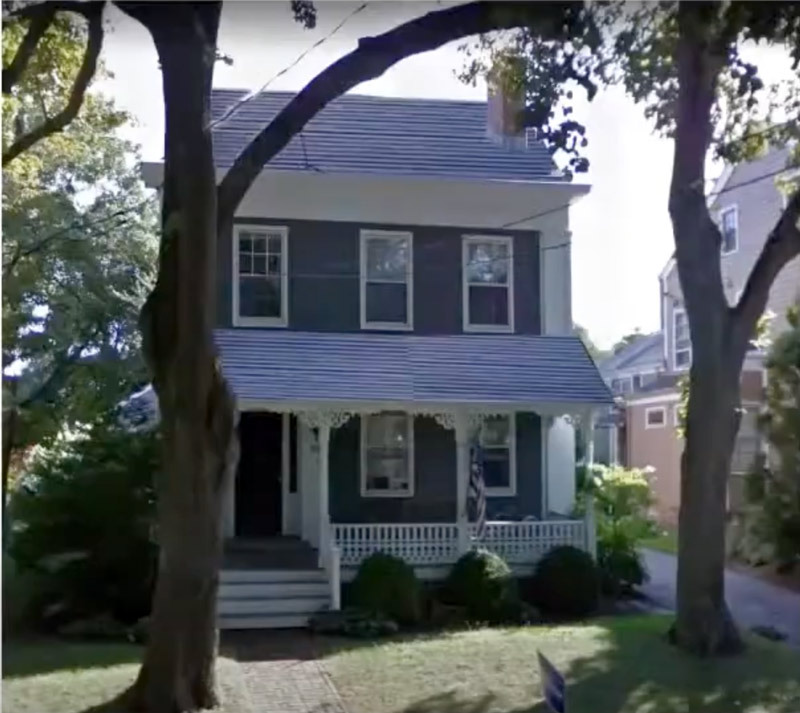
A proposal to replace the roof of a historic home in Sag Harbor with Tesla solar tiles was met with both interest and hesitation during the Sag Harbor Village Historic Preservation & Architectural Review Board’s November 19 meeting.
Mary Ann Eddy, who chairs the village’s Harbor Committee, is seeking approval to install the Tesla Solar Roof on her house at 96 Hampton Street. The Historic Preservation & Architectural Review Board previously approved such a roof for a Howard Street home, but in that case, the house was not historic.
Anais Fernandez of Tesla Energy told the board that the plan calls for 185 Tesla solar tiles, each of which is 1 foot by 3 feet. She noted that these tiles are twice the size of the tiles used at Howard Street and more efficient. She presented a photograph of the house viewed from the street, with solar tiles digitally added to the roof, and said they have a “beautiful, sleek look.”
Dean Gomolka, the chairman, said that the board previously gave solar tiles a shot on Howard Street because they look like shingles rather than solar panels, which he called “giant things” that look like they do not belong anywhere.
Board attorney Elizabeth Vail pointed out that the village code states that solar and alternative energy systems shall not be visible from adjacent streets or adjacent properties in the historic district.
Board member Judith Long noted that the Howard Street house was less visible than 96 Hampton Street. “These are going to be very obvious,” she said, “and so we need to be very careful. … I’m worried about what they’re going to look like on this historic house.”
The board’s historic preservation consultant, Zachary Studenroth, pointed out that the board’s purview includes not just what can be seen from the street, but what can be seen from neighboring houses as well.
“This is a house that sits in a row, interestingly enough, of Greek Revival period houses,” Mr. Studenroth said. “This is 1840s or so. It has a porch that was added in the 1880s, but that’s also considered contributing.”
He was concerned about the look of the tiles. “If they’re black and shiny, they’re going to look a little strange,” he said.
Mr. Studenroth questioned if the tiles would only be installed on the back slope of the house — which is south facing and where solar tiles will collect the most sun. “That enables the front of the house to be shingled in a conventional way, and that is what the majority of people will see as they drive around the village,” he said.
Ms. Eddy explained that the entire roof is going to be replaced. “Not all of the tiles are going to be photovoltaic, but that won’t be discernible from the street,” she said, also noting that she will require solar tiles on both the front and back of the house to capture enough solar energy.
Ms. Fernandez offered to drive a sample solar tile out to Sag Harbor so board members could see it for themselves.
The application was adjourned to give board members the opportunity to visit the house and to see the tile.
Picking up on a discussion that began a week earlier, the Historic Preservation & Architectural Review Board heard a revised pitch for expanding a bungalow at 32 Glover Street, in the historic district.
A week earlier, the board rejected plans to demolish the one-story house and replace it. An alternative presented at the same meeting called for connecting the bungalow to a new Greek Revival structure — but the board did not like that idea either, finding the mixture of two architectural styles objectionable.
The latest iteration of the plan changes the proposed connector from one story to two, and the orientation of the two-story addition was turned 90 degrees. Now, the gable faces the street, matching the bungalow.
“We understood from your comments last week that you’re looking for greater cohesion between the original structure … and the new addition,” said Haley Willis, the attorney for the applicant. “So these new plans are designed to be more harmonious with the original cottage. The addition was simplified to be more compatible with the original structure. There’s less of a contrast in styles. It’s a more comfortable scale so the new addition does not overwhelm the existing building.”
Ms. Willis asked if the plans are going in the right direction.
Mr. Studentroth said the addition is still pretty sizable, compared to the existing one-story house, and the addition appears to be a modified Greek Revival style.
“I don’t think it’s at all appropriate,” he said, noting that the architectural style is from 60 years earlier than the style of the bungalow.
Ms. Long suggested the design be a closer match to the 1930s bungalow style. “You can take that bungalow style and make something quite wonderful that would complement the original building, and fill it with arts and crafts furniture — and really do a bungalow,” she said.
Mr. Gomolka agreed that the two styles are incongruent but said he favors the layout. “I like the balance that’s going on,” he said. “I like the feel of the property. I just think, to Zach’s point, the Greek Revival might be a little bit too much.”
Mr. Studenroth added that the proposed connector is too big, and Mr. Gomolka suggested the ridge be dropped down below the height of the original structure.
The applications was adjourned for further revisions.